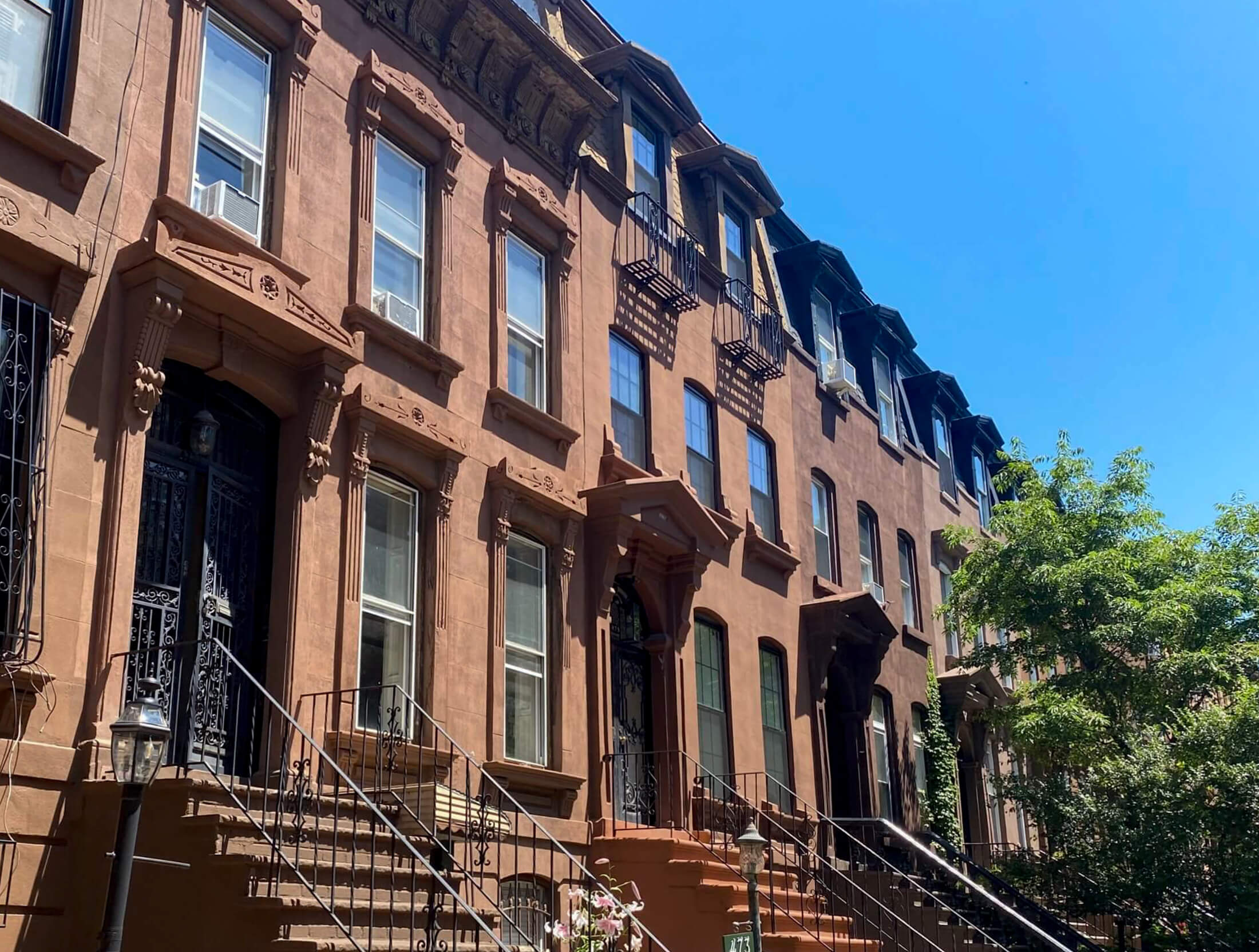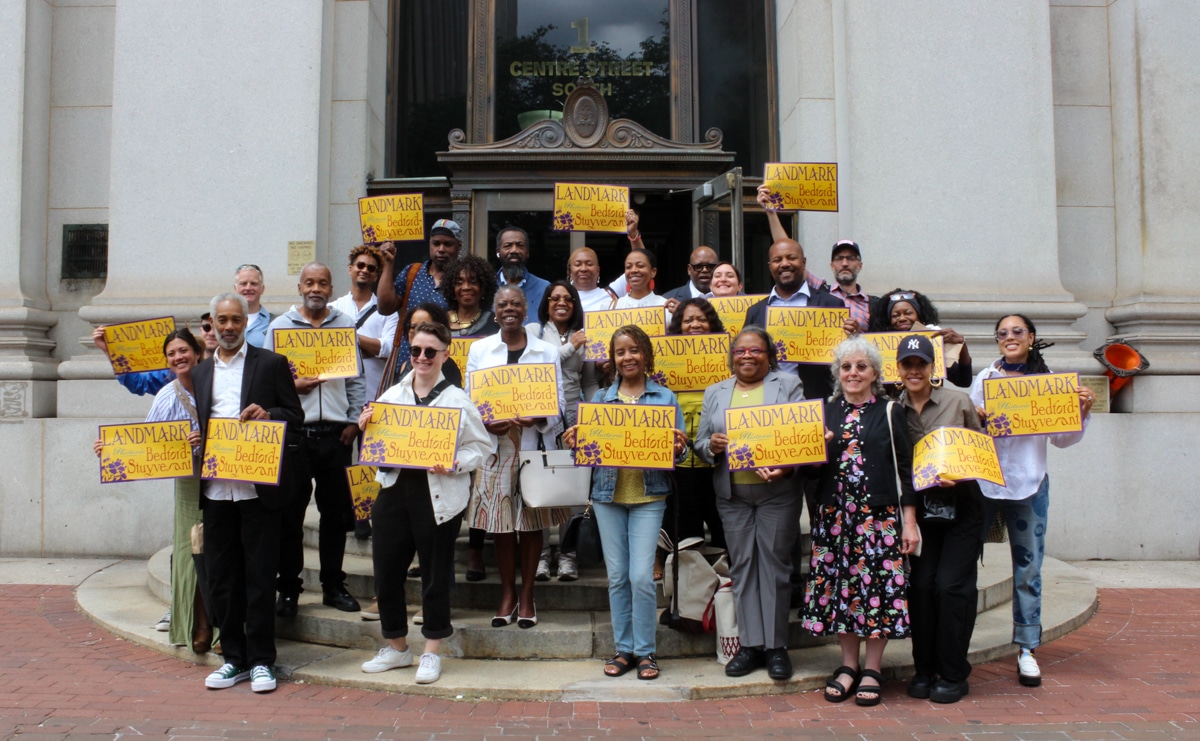Locals Celebrate Creation of Bed Stuy's Willoughby-Hart Historic District
The city’s Landmarks Preservation Commission today voted unanimously to landmark two Bed Stuy blocks as a new historic district.

Residents of Willoughby Avenue gathered to re-create a historic photo earlier this month. Photo by Anna Bradley-Smith
Almost two years after Willoughby Avenue’s historic Jacob Dangler mansion was torn down during a landmarking review process, sending many neighbors into mourning, Willoughby Avenue and Hart Street locals were jubilant today after the city’s Landmarks Preservation Commission voted unanimously to preserve their blocks of predominantly late 19th century Neo-Grec brownstones.
The packed viewing room broke into applause and tears as the commissioners declared the two block area between Nostrand and Marcy avenues the city’s newest historic district: The Willoughby-Hart Historic District.
“It’s bringing tears to my eyes, to be here, to hear this,” unofficial Willoughby Avenue “mayor” Michael Williams told the commissioners from the audience after the vote passed.
“Growing up, my parents, they worked so hard, on Willoughby Avenue, that area was redlined, my parents couldn’t get a loan to have a business, so my brother and sister and I, we struggled so hard to maintain that building and to this day I still love this block and that building and I appreciate what you’ve been doing for us, thank you, from the bottom of my heart,” he said.

The designation marked the end of a long process for local residents who had been particularly active in advocating for designation since the Dangler mansion’s demolition, but whose advocacy for protecting and preserving the block dated back generations. LPC research staff said the block was first looked at for designation by the commission in 1992.
Before the vote took place, LPC Chair Sarah Carroll said when she went on a site visit to tour the area she found “these streets really stood out architecturally within their immediate surroundings.”
“Further, it was my impression that these streets were comparable to the already designated streets in the other Bed Stuy historic districts in terms of style and integrity,” she said, before adding “I would strongly urge that we consider designation of these two standout streets based on their architectural and historic merit.”
“These streets are lined with row houses that were built within a 20-year timeframe, beginning in 1871, during a time that the area was rapidly transforming from farmland to dense residential development, and built in varying styles that were popular at the time, including Neo-Grec, Second Empire style, Queen Anne and Romanesque Revival styles, and the consistency of their development and the variety of the stylistic features provide both unity and variety that, I believe, creates a distinct sense of place,” Carroll said.

Carroll said to those both for and against landmarking that it isn’t the commission’s job to stop change, and that LPC frequently allows rooftop and rear yard extensions and it will continue to do that.
She said the commission had done extensive homeowner outreach around landmarking, which included three public meetings and a number of one-on-one conversations, and it will continue to work with homeowners who are considering making changes to their homes.
The tumultuous public review period saw petitions both in favor and against landmarking gaining more than 1,000 signatures each, and in today’s meeting LPC staff said the commission received 117 letters of support, including from City Council Member Chi Ossé, and 115 letters in opposition. Those letters were on top of the 57 people who spoke at the public hearing earlier this month, including local Assembly Member Stefani Zinerman and State Senator Jabari Brisport, who both supported landmarking. Twelve of the 57 spoke against landmarking.

Of the 12 who spoke against landmarking at the hearing, most said a designation would be discriminatory to Jewish families who need larger homes to accommodate their families. Adam Leitman Bailey, a real estate lawyer representing local Jewish owners, said those pushing for landmarking were being antisemitic and invoked October 7 saying “never in the history of the United States of America has a body voted to remove this many Jews from streets through passing a vote via a law and government body.”
Bailey accused the commission and local community board of excluding the Jewish community from the landmarking process, and said actions by the commission amount to housing discrimination.
LPC commissioner Michael Goldblum, who was unable to attend today’s meeting and sent a statement that was read by Carroll before the vote, said he was “deeply troubled by the public testimony” at the hearing and said the accusations thrown around amounted to “a staggering event, one of the most troubling and bizarre hearings I can recall in my 14 years as a commissioner.”
“The accusing testifiers did so because they said a landmark designation would limit a homeowner from enlarging his or her building, unavoidably forcing people with large families to move out. There are many questions I could ask them to try to find any merit in what seems to me to be a very weak argument,” Goldblum’s statement said. He added that a number of city agencies limit what a person can build, and questioned if that makes all those agencies antisemitic.
He said while LPC does impose constraints on development, “anyone who has spent a half hour watching our YouTube hearings or sitting here in this room on any given Tuesday would attest landmark districts are full of change, awash in enlargements, and open to reasonable arguments, to consider special conditions when possible.”
He added that, regrettably, antisemitism is real and as “an observant Jew with a personal familiarity with the pain that antisemitism can cause, I would say that anyone, especially a Jew who uses the accusation of antisemitism or racism cynically or otherwise to influence a land-use process like this, is doing all Jews and all minorities a disservice, because to misuse the claim is to diminish its power.”

Goldblum said that while the Willoughby-Hart district is charming, “it is neither unique nor pristine,” but added the LPC regulations do not require uniqueness or perfection. “They require a determination, first by staff and then by us, that the district possesses qualities of historical and cultural importance sufficient to merit, in our view, landmark protection.”
“I, for one, find that it meets those standards, comparing this district to similar districts and finding it similar enough in quality and historic interest to merit protection,” he said. “I am confident that if this district is approved today, it will be administered by the staff, Jews and non Jews alike, with the same fairness [and] openness that they offer to other communities and individuals of any color, race, religion, ability, gender, or sexual orientation, whose buildings are protected by our regulations.”
Goldblum’s statements were met by applause from the room and support from his fellow commissioners.

As Bed Stuy locals poured out of the hearing room after the vote, hugging, crying, and congratulating each other, many reflected on the process of landmarking and the relief they were feeling that the vote had gone their way.
“I’m overjoyed at LPC’s decision this morning. It was earth shattering for us,” Joanne Joyner-Wells told Brownstoner after the vote. She said locals have no issue with who owns houses on the block, but landmarking is about “what you do with the house that you purchase.”
Joyner-Wells said neighbors had worked for each other and their community to get the vote to come to pass, and she noted a number of elderly homeowners couldn’t be there to see it in person and thanked the younger generation for picking up the mantle.
“We’ve worked so hard to preserve the history of our homes, our neighborhood, and the entire community, so for the vote to go in our favor is just a blessing to all of the work we’ve done.”
Related Stories
- Bed Stuy Homeowners Call on LPC to Preserve Historic Brownstone Blocks
- Proposed Willoughby-Hart Historic District to Get Public Hearing at LPC
- Locals Talk Next Steps for Landmarking Willoughby Hart Historic District
Email tips@brownstoner.com with further comments, questions or tips. Follow Brownstoner on Twitter and Instagram, and like us on Facebook.









power of 1933 Germany
So happy to have played a miniscule part in this process, and I’m very pleased with this designation. The people on Willoughby-Hart worked so hard and so diligently on a process that requires patience and steadfastness. Especially after the Dangler mansion debacle. Congratulations!!